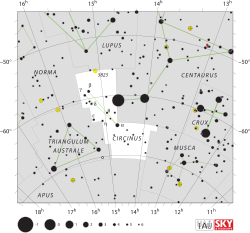Alpha Circini
| Observation data Epoch J2000.0 Equinox J2000.0 (ICRS) |
|
|---|---|
| Constellation | Circinus |
| Right ascension | 14h 42m 30.41958s |
| Declination | −64° 58′ 30.4934″ |
| Apparent magnitude (V) | 3.18 - 3.21 |
| Characteristics | |
| Spectral type | A7 Vp SrCrEu |
| U−B color index | +0.12 |
| B−V color index | +0.24 |
| Variable type | roAp |
| Astrometry | |
| Radial velocity (Rv) | +7.2 km/s |
| Proper motion (μ) |
RA: −192.53 mas/yr Dec.: −233.51 mas/yr |
| Parallax (π) | 60.35 ± 0.14mas |
| Distance | 54.0 ± 0.1 ly (16.57 ± 0.04 pc) |
| Details | |
| Mass | 1.5–1.7 M☉ |
| Radius | 1.967 ± 0.066 R☉ |
| Luminosity | 10.51 ± 0.60 L☉ |
| Surface gravity (log g) | 4.1 cgs |
| Temperature | 7,500 K |
| Metallicity [Fe/H] | 0.13 dex |
| Rotation | 4.4790 ± 0.0001 days |
| Rotational velocity (v sin i) | 13.0 ± 1.5 km/s |
| Age | ~12 million years |
| Other designations | |
| Database references | |
| SIMBAD | data |
Alpha Circini (α Cir, α Circini) is a variable star in the faint, southern, circumpolar constellation of Circinus. At an apparent visual magnitude of 3.19, it is the brightest star in the constellation and can be readily seen with the naked eye from the southern hemisphere. Parallax measurements of this star yield an estimated distance of 54.0 light-years (16.6 parsecs) from the Earth.
This star belongs to a class of variables known as rapidly oscillating Ap stars. It oscillates with multiple, non-radial pulsation cycles and a dominant cycle of 6.8 minutes. The spectrum shows peculiar features caused by chemical stratification of the outer atmosphere. It displays a moderate deficiency of carbon, nitrogen and oxygen, while there is an overabundance of chromium (Cr). The stellar classification of A7 Vp SrCrEu indicates that this is a main sequence star with enhanced levels of strontium (Sr), chromium, and europium (Eu) in its atmosphere (compared to a typical star like the Sun).
The mass of Alpha Circini is about 150% to 170% the mass of the Sun and it has double the Sun's radius, while the luminosity is more than 10 times that of the Sun. The effective temperature of the outer envelope is about 7,500 K, giving it the white hue typical of A-type stars. It is rotating with a period of 4.5 days and the pole is inclined by about 37 ± 4° to the line of sight from the Earth.
Based upon its location and motion through space, Alpha Circini is a candidate member of a stellar kinematic group known as the Beta Pictoris moving group. This group shares a common origin and has an estimated age of about 12 million years. At the birth of this group, Alpha Circini was estimated to be located at a distance of about 91 ly (28 pc) from the center of the assemblage.
...
Wikipedia

